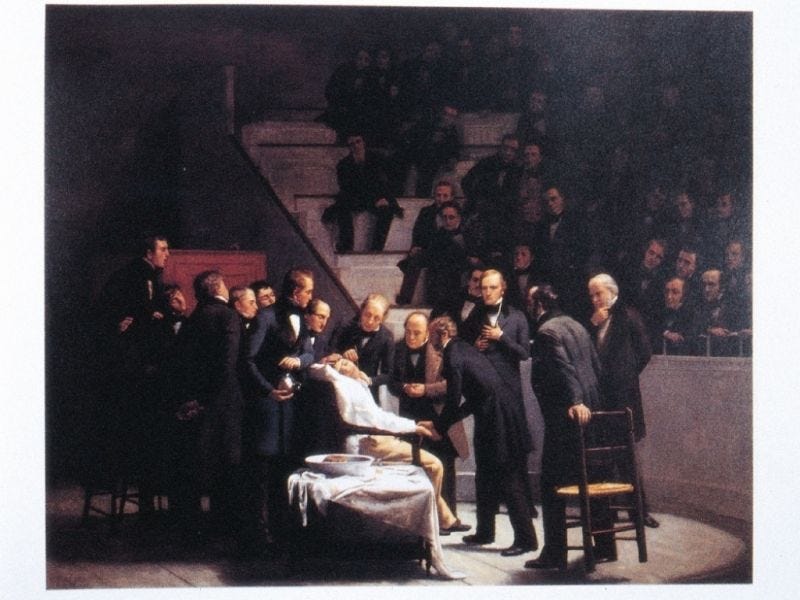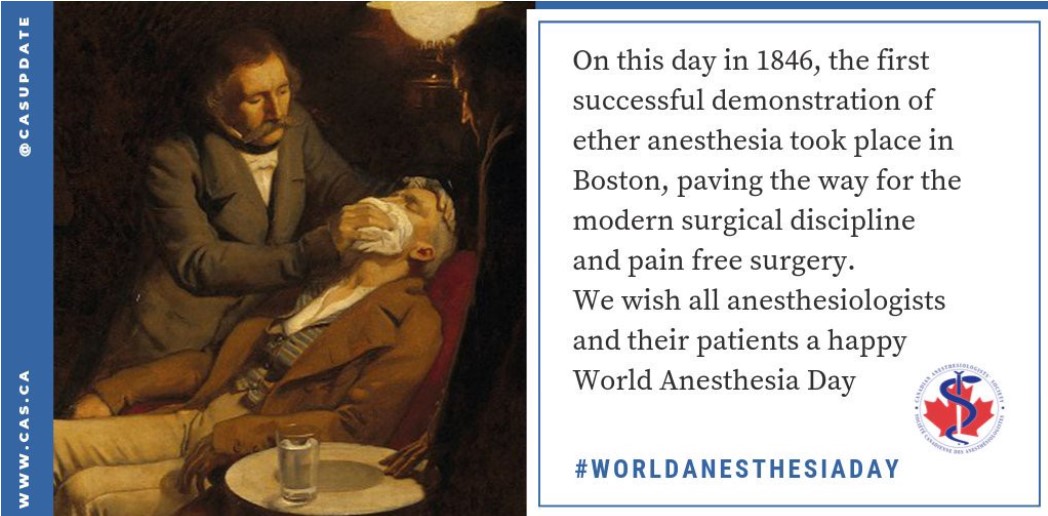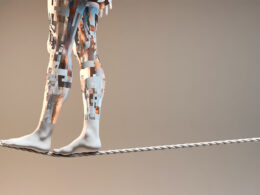Also known as National Anaesthesia Day or Ether Day in some countries, World Anaesthesia Day is marked globally and annually on October 16, to commemorate the discovery of anaesthesia.
Utkal Today
Anwesha Mishra
October 16, 2020
Ranked as one of the significant events in the history of medicine, World Anaesthesia Day or Ether Day is an annual event observed globally on October 16 to commemorate the first successful demonstration of diethyl ether anaesthesia.
It took place in an operating theatre (now known as the Ether Dome) at the Massachusetts General Hospital, home of the Harvard School of Medicine.
The discovery made it possible for patients to obtain the benefits of surgical treatment without having to endure the pains of an operation.
This day is also known as National Anaesthesia Day or Ether Day in some countries.
Special events have been held to commemorate the date since at least 1903.
The World Federation of Societies of Anaesthesiologists celebrates World Anaesthesia Day annually with over 134 societies representing anaesthesiologists from over 150 countries taking part.
History and discovery of World Anaesthesia Day
About 173 years ago, on October 16, W.T.G Morton made the first official successful demonstration of ether as an anaesthetic which heralded the era of the practice of anaesthesiology and is celebrated as World Anaesthesia Day.

And in the time since, the science and art of anaesthesia has evolved and advanced at a rapid pace to the current scenario, where the anaesthetist’s role is not just limited to the time of surgery, but has permeated into the fields of pain control, palliative care, critical/intensive care and is still constantly evolving.
The World Federation Societies of Anaesthesiologists (WFSA), in collaboration with the International Liaison Committee on Resuscitation (ILCOR) runs the “World Restart a Heart Day” campaign on the occasion of World Anaesthesia Day.
This is a global initiative, which started in 2018 to increase the awareness of bystander CPR, in addition to increasing the overall bystander CPR rates.
Utilising the network and reach provided by the International Federation of Red Cross and Red Crescent Societies to train and raise awareness amongst the general public of the importance of knowledge of CPR and provide training for the same, the World Restart a Heart campaign in its second year looks to further this cause.
Lesser known facts about anaesthesia
About 60,000 patients undergo all types of surgery and other medical procedures every day with the help of these pain-relieving drugs, according to the National Institutes of Health (in the USA).
There’s no doubt that anaesthesia — whether inhaled as a gas or injected into your bloodstream by a highly trained doctor, dentist, or nurse anaesthetist — has enabled millions of people to receive medical treatments that lead to longer and healthier lives.
There are four main categories of anaesthesia used during surgery and they are
- general anaesthesia,
- regional anaesthesia,
- sedation aka “monitored anaesthesia care” and
- local anaesthesia.
Here are some interesting facts about anaesthesia:
- Smokers need more doses of anaesthesia than non-smokers
- Anaesthesia does not always put you to sleep
- Regaining consciousness during surgery is possible
- Being overweight increases the chances of complications
- Doctors are researching the different functions of anaesthesia
- Anaesthesia affects memory
Smokers need more doses of anaesthesia than non-smokers
Anaesthesiologists have long noticed that smokers often need extra anaesthesia. Smokers have irritated airways.
As a result, they may need higher doses of pain medication to improve their tolerance with the breathing tubes.
Interestingly, people who smoke or ingest marijuana (cannabis) on a daily or weekly basis may need more than twice the usual level of anaesthesia for routine procedures, such as endoscopies, a study published in May 2019 in The Journal of the American Osteopathic Association found.
Anaesthesia does not always put you to sleep
Local anaesthesia only numbs a small area of the body to prevent pain during a procedure like having a tooth pulled, getting stitches for a deep cut, or having a mole removed.
Regional anaesthesia suppresses pain and movement in a larger area of the body, but leaves you fully conscious and able to talk and answer questions. An epidural given during childbirth is one example.
General anaesthesia affects the whole body, making you unconscious and unable to move. It’s typically used for major and time-consuming operations.
In smaller doses, general anaesthesia medication can be used to induce something called “twilight sleep,” a less powerful type of anaesthesia that sedates you so that you are sleepy, relaxed, and unlikely to move or know what’s going on.

Regaining consciousness during surgery is possible
According to the American Society of Anaesthesiologists (ASA), regaining consciousness during surgery is an extremely rare case, occurring in only 1 or 2 of every 1,000 medical procedures involving general anaesthesia.
This condition, called “anaesthesia awareness,” occurs when a patient becomes aware of their surroundings and of events occurring during the surgery.
Such awakenings are usually brief and patients usually do not feel pain.
Anaesthesia awareness can be more common in high-risk patients who have multiple medical conditions, or those who are being treated for an emergency, in which the usual dose of anaesthesia cannot be safely given.
Being overweight increases the chances of complications
It’s harder for anaesthesiologists to provide the best dose of medication and deliver that medication intravenously to patients who are significantly overweight, according to the ASA.
In addition, obesity increases the risk of sleep apnea, a condition that causes frequent pauses in breathing. This can ensure you get enough oxygen and airflow, especially during general anaesthesia, more difficult.
Losing weight before surgery can decrease the risk of complications.
Doctors are researching the different functions of anaesthesia
Back when anaesthetics had just become part of routine surgery, doctors who administered them knew very little about how they worked, according to the National Institute of General Medical Sciences (NIGMS).
Today, it’s believed that anaesthetics disrupt nerve signals by targeting specific protein molecules inside nerve cell membranes. As scientists continue to learn more about anaesthesia, these drugs will only become more effective, says the NIGMS.
Anaesthesia affects memory
General anaesthesia may cause memory loss that can last for days, even months. Some of this memory loss may be due to factors other than anaesthesia, such as inflammation or stress triggered by the surgery. But some is likely due to anaesthesia’s effect of memory-loss receptors in the brain.
What’s more, a more recent Mayo Clinic study, published in the August 2018 issue of the British Journal of Anaesthesia, suggested that exposure to anaesthesia can trigger enough of a decline in brain function to unmask hidden pre-existing memory problems in patients over age 70.
Mysteries and complications of anaesthesia
Medical experts do not completely understand the way anaesthesia affects the brain, and sometimes serious complications can occur. According to a recent article in The Wall Street Journal, as more outpatient centres perform surgical procedures with faster-acting anaesthetics, such as propofol, there is an increasing need to better prepare medical staff to prevent and handle anaesthesiology emergencies.
“Bite the bullet”
Before Anaesthesia, Patients were told to “Bite the bullet.” This popular phrase has a meaning that dates back to a time before there was anaesthesia.
A wounded patient, often a soldier, would be told to “bite the bullet” while enduring painful surgery without anaesthetic.
Aside from bullets, patients were often given sticks, leather straps, and other objects to clench between their jaw during painful procedures.

Originally published at https://www.utkaltoday.com on October 16, 2020.











